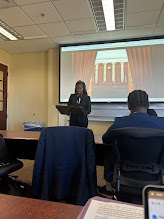Today in the court, we were presented with a precedent setting case, Board of Regents v. Bakke. This case centers around the Equal Protection Clause of the 14th Amendment.
This case is based on the University of California's medical school which set a numeric quota for its admissions department. This stated that the university would admit 10 African American students. This interfered with Mr. Bakke's application because while he was one of the most qualified applicants, he did not get accepted due to his skin color.
Arguments from the Board of Regents were made first. The first of which urged the court to consider that Bakke's case should not be thought of in isolation. We were also told of groundbreaking programs at other universities including Clemson and Arizona State which both have Affirmative Action policies.We were told by the Board of Regents that their policy was narrowly tailored for a historically discriminated against people group, and that fostering diversity lended increased academic success. We were once again pointed to the idea that this case was about more than Mr. Bakke as we were pointed to black pioneers like Charlene Hunter and James Meredith.
We were encouraged to think of race as only one factor and realizing that more critical thinking occurs in a diverse student body. We were also pointed to the enhancements made to students' medical education by being involved within a diverse student body.
The lawyers for the Board of Regents also pointed us to a similar policy seen in the Fair Housing Act. We were told that this policy is simply part of a larger zeitgeist. If our country felt it was important enough to have anti-discriminatory policies in housing, we should have similar policies in education as well.
We were also told to look at the policy from an economic perspective. The board argued that the policy at their school would help expand overall diversity in the medical field which would mean increased African American success which would mean the entire economy was better off.In the end, the Board pointed us back to the 14th amendment stating that it was neutral on its face and that it is not intended to benefit one race over the other. We were also pointed to the fact that the policy does follow strict scrutiny which is having a compelling interest, there being a close nexus between the law and regulations and then final goals, and it being narrowly tailored to only affect the people it must.
We also heard from the lawyers on the side of Mr. Bakke. The first argument pointed us to the fact that discrimination of any form against any person is unjust. We were told that it does no good to replace one form of discrimination with another.
We were then pointed to the qualifications of Mr. Bakke who had a 3.5 GPA and excellent scores on his medical exams. We were told that the quota system was unfair because it put emphasis on race when the emphasis should be on a neutral metric system.
We were also told that excluding one group of students did not empower the other. This idea ran in tandem with the idea that African Americans had many educational opportunities elsewhere. There were many historically black universities in the area, so African Americans were not missing out.We were then pointed to economic viewpoint of an argument against this policy. We were told that meritocracy requires economic efficiency to make it financially strong, which does not occur when we lower standards to account for race. We were told the labor market is extremely competitive and needs to consist of hard workers who earned their way there.
Lastly we heard the law argument on the side of Mr. Bakke which pointed us once again to the 14th amendment claiming Mr. Bakke's rights were violated when he was rejected because he was not African American. We were told that he is not just a number and should not be treated as one. We were also pointed to his immense probability of success as we were told he was not responsible for past injustices and should not be punished because of them.
As the judge wrapped up the hearing, the decision was made to rule in favor of a new policy. Neither party won entirely, but instead a compromise was made that race should be just one of many factors when deciding admissions. This way no one is discriminated against and everyone has a fair opportunity to gain an education.
























